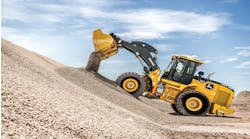In Weigh the Evidence, Larry Kaye writes about dealers entering the rental business. Kaye has studied this topic for years and has given seminars and consulted with dealers on their rental operations.
Personally, I have visited quite a few dealers that have done very well in the rental business. The ones that have succeeded, from what I have seen, have come to understand a rental mindset and worked to set up a structure that accommodates short-term rental as opposed to the more long-term rental that goes along with a rent-to-own business model. It’s also quite different than renting out a machine to a customer who owns a machine that is in the dealer’s shop. It’s just something they have to do, serving the customer who is essentially interested in owning machines and bringing it to the dealership for service. The dealership will rent him a replacement machine because it’s part of the required customer service, not because they want to encourage the customer to be an ongoing renter.
The trend of dealers getting into rental was fueled by the dramatic movement towards rental by Caterpillar dealers in the 1990s. One of the compelling causes of Caterpillar dealerships getting into short-term rental en masse was the realization that Caterpillar was missing out on a huge customer segment – the smaller contractors who are such a huge portion of the rental customer base. Many of these are small businesses basically operating out of the back of a pick-up truck. They can’t afford to purchase D-9s, but they might rent smaller Caterpillar machines and what Caterpillar calls allied machines such as air compressors, generators, scissorlifts and more.
People in the Caterpillar organization realized that this was the gravy of the construction equipment business and its dealers, with a few exceptions, were missing out on it. And, of course, as some of these organizations grow, they might want to buy some larger machines --- and Caterpillar recognized the potential of this customer segment.
I don’t know how to quantify it, but a large percentage of Caterpillar dealerships have done very well with rental, and they recognize that it is a different business model and structure and mindset than the typical business of a dealership. Many of those Caterpillar dealers hired veterans of the rental industry to work in and manage their rental departments or rental centers and these rental-minded staffers were huge contributors to the success of these new ventures.
Years ago, I heard an explanation of the difference between the rental business and a dealership business: In a dealership, you sell a customer a machine and you hope to not see him too often after that, although those that do well in the aftermarket service business wouldn’t quite agree with that concept. On the other hand, in the rental business you want to see them as often as possible. Come by or call or email or go online to rent a machine any day.
So dealers that want to do the rent-to-rent business for all the good reasons that Larry Kaye talks about in his fine article on page 16, you must realize that you need to set up a different business structure if you want to be successful in rental. It has to do with mindset, and it has to do with having staff that understands the rental business.
And it’s all about urgency. When somebody contacts your dealership wanting to acquire a crawler excavator or wheel loader, they probably aren’t expecting to pick it up that very afternoon because they have a job going and need it in two hours. But in rental, that’s often the way it works. You have to be set up to see that request as a great opportunity rather than a bit of a nuisance. The rental business is urgency, immediacy and the daily repetition of a level of efficiency not typically required of a dealership. You can learn to do it and do it well, but it takes the right structure, the right people and the right attitude.
In a dealership, a purchaser might be fine with delivery in a week or maybe three months depending on equipment lead times. But ordering a unit for a short-term rental is more like ordering a pizza. They are hungry now, and it better be hot. There’s a breakdown on a jobsite and a dozen workers and eight other machines are waiting for that rental replacement.
Make sure you are set up for that kind of response.







